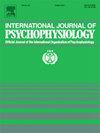语言内和跨语言词汇语义效应对翻译发音方式的电生理关联。
IF 2.6
3区 心理学
Q3 NEUROSCIENCES
引用次数: 0
摘要
本研究探讨了内语和跨语词汇语义信息对不平衡汉英双语者前后翻译发音方式影响的电生理机制。被试采用双语侧卫范式,对被试和侧卫之间的语言一致性(一致vs不一致)和语义相关性(即语义相关vs不相关vs相同)进行控制,并测量行为和事件相关电位(erp)数据,以追踪这两个变量的相对贡献。行为数据显示,正向翻译比反向翻译的响应时间更快,错误率更高。此外,双语者对一致语境的错误率高于对不一致语境的错误率和反应时间。此外,ERP数据显示,前向和后向翻译过程都受到语义相同的侧边词的跨语言(不一致)词汇信息的影响,这反映在P200(150-300 ms)分量的调制上。同时,正向和反向翻译过程受益于汉语侧边词的语义表征,语义相同条件下的负N400(300-600 ms)振幅小于不相关条件下的负N400。更重要的是,汉语侧读诱发的激活也交互地传播到语义相关的类别,相关条件的负N400振幅小于不相关条件。与此同时,无论翻译方向如何,当侧边为英语单词时,相同条件下的N400负向振幅也低于不相关对照。这些发现是在多链接模型的框架下解释的,根据该模型,无论翻译方向如何,翻译发音都涉及语言内和跨语言的词汇语义激活,并且上述过程受语言语境的调节。本文章由计算机程序翻译,如有差异,请以英文原文为准。
Electrophysiological correlates of within- and cross-language lexical-semantic effects on the way to translation articulation
This study investigated the electrophysiological correlates of the impact of within- and cross-language lexical-semantic information on the way to forward and backward translation articulation in unbalanced Chinese-English bilinguals. Participants were tasked with a bilingual flanker paradigm, in which the language congruency (congruent vs. incongruent) and semantic relatedness (i.e., semantically related vs. unrelated vs. identical) between the targets and flankers were manipulated, and the behavioral and event-related potentials (ERPs) data were measured to track the relative contributions of these two variables. Behavioral data revealed faster response time and higher error rate for forward than for backward translation. Additionally, bilinguals exhibited a higher error rate and slower response time for congruent than for incongruent contexts. Furthermore, ERP data revealed that both forward and backward translation processes were impacted by the cross-language (incongruent) lexical information of the semantically identical flanker words, as reflected by the modulation of the P200 (150–300 ms) component. Meanwhile, the forward and backward translation processes benefited from the semantic representation of Chinese flanker words, as reflected by less negative N400 (300–600 ms) amplitudes for semantically identical condition than for unrelated control. More importantly, the activation induced by Chinese flankers also interactively spread to the semantically related categories, as reflected by less negative N400 amplitudes for related condition than for unrelated control. Meanwhile, identical condition also elicited less negative N400 amplitudes than unrelated controls regardless of translation directions when the flankers were English words. These findings were interpreted in the framework of the Multilink model, according to which translation articulation involves both within- and cross-language lexical-semantic activation regardless of translation directions, and the above processes are modulated by language contexts.
求助全文
通过发布文献求助,成功后即可免费获取论文全文。
去求助
来源期刊
CiteScore
5.40
自引率
10.00%
发文量
177
审稿时长
3-8 weeks
期刊介绍:
The International Journal of Psychophysiology is the official journal of the International Organization of Psychophysiology, and provides a respected forum for the publication of high quality original contributions on all aspects of psychophysiology. The journal is interdisciplinary and aims to integrate the neurosciences and behavioral sciences. Empirical, theoretical, and review articles are encouraged in the following areas:
• Cerebral psychophysiology: including functional brain mapping and neuroimaging with Event-Related Potentials (ERPs), Positron Emission Tomography (PET), Functional Magnetic Resonance Imaging (fMRI) and Electroencephalographic studies.
• Autonomic functions: including bilateral electrodermal activity, pupillometry and blood volume changes.
• Cardiovascular Psychophysiology:including studies of blood pressure, cardiac functioning and respiration.
• Somatic psychophysiology: including muscle activity, eye movements and eye blinks.

 求助内容:
求助内容: 应助结果提醒方式:
应助结果提醒方式:


